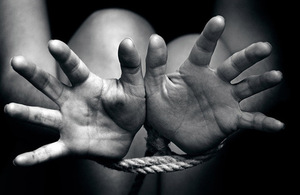Increasing numbers of nationals from Vietnam, Albania and Romania among the victims
The Gangmasters and Labour Abuse Authority (GLAA), a non-departmental public body, yesterday published a report examining the scale of labour exploitation and modern slavery in the UK.
 Image credit: UK GovernmentThe 33-page report is available here and it provides an updated assessment of the threats previously identified in the GLAA's original report on modern slavery from 2016, as well as looking at newly emerging trends in 2017 and a forecast of possible threats into 2018.
Image credit: UK GovernmentThe 33-page report is available here and it provides an updated assessment of the threats previously identified in the GLAA's original report on modern slavery from 2016, as well as looking at newly emerging trends in 2017 and a forecast of possible threats into 2018.
According to the GLAA, the scale of modern slavery is increasing across the UK, though it remains difficult to accurately assess due to the hidden nature of the threat.
In 2016, 3,805 potential victims of all exploitation types were referred into the National Referral Mechanism (NRM) in the UK and 782 potential adult victims were referred to the duty to notify provision in England and Wales. In the twelve months up until March 2017, police in England and Wales recorded 2,255 modern slavery offences, with 60 recorded by Police Scotland and 35 by the Police Service of Northern Ireland. In 2017, 5,145 potential victims of modern slavery were submitted to the NRM, a 35% increase compared with 2016.
The report notes that these figures are far lower than the 13,000 estimate from the Home Office (which in itself has been described as being "far too modest" by the Independent Anti-Slavery Commissioner), indicating that a significant proportion of potential victims remain vulnerable.
The top ten countries of origin of NRM potential victims between 2015 and 2017 were Vietnam, Albania, the UK, Romania, Poland, Sudan, China, India, Eritrea and Slovakia.
Vietnamese nationals continue to show a sustained increase in numbers, as do Romanians and Albanians, while the number of Polish potential victims has seen a decline.
The GLAA says 'debt bondage' is an increasing tactic used by criminals, where victims are forced to work off debts they have no control over. In addition, victims of modern slavery tend to live in poor conditions without basic facilities like electricity, heating and water. They are threatened with losing their jobs if they find somewhere else to live.
The sectors identified in the report most at risk of labour exploitation and modern slavery are agriculture, nail bars, catering/hotels, car washes, warehouses/distribution, food processing, shellfish gathering, manufacturing, recycling/waste disposal, cleaning and construction.
Looking to future threats, the GLAA says Brexit is likely to be the predominant factor that changes the intelligence picture concerning labour exploitation over the next few years. The report notes: "Dependent upon entry and working restrictions, there may be an increase in illegal working, misrepresentation and / or false and fraudulent documents being used, for example. Companies in the construction sector have reported difficulties in recruiting staff, likely due to a decrease in the migrant workforce after the UK's independence referendum,"
Minister for Crime, Safeguarding and Vulnerability Victoria Atkins said: "The barbaric nature of modern slavery means it destroys the lives of its victims, which is why we introduced the world-leading Modern Slavery Act 2015 and increased the Gangmasters and Labour Abuse Authority funding by £2.6m a year to help tackle modern slavery and wider labour exploitation.
"This report is part of the GLAA's crucial work to understand the scale of exploitation of vulnerable workers so that law enforcement can identify and protect victims, and convict their perpetrators. I am pleased that the GLAA has made over 100 arrests since their new powers came into force in May last year."
In related news, the House of Commons Public Accounts Committee last week published a report on modern slavery, which you can read here.
The Committee found that the Government still lacks data and systems to properly understand the crime, its victims and perpetrators.
The report's summary states: "The Home Office (the Department) introduced an ambitious Modern Slavery Strategy in 2014, but it has taken too long to learn what works in the system, to understand the complexities of the crime and to turn the strategy and the Modern Slavery Act into an effective and co-ordinated approach across government.
"Government does not yet have the data or systems to understand the crime, the demographics and circumstances of the victims and the perpetrators, making the digitisation of the National Referral Mechanism (NRM) a priority.
"Nor does it know how much money it spends tackling modern slavery or what success looks like, meaning it cannot establish whether its strategy is working or how it should prioritise its actions.
"Potential victims are waiting far too long for a decision on whether they will be treated as a victim of modern slavery, causing further distress and anxiety to vulnerable people.
"The Department has not put in place minimum care standards and it does not inspect the level of care provided to potential victims, so it does not know whether or not victims are receiving adequate care.
"The Department also does not know what happens to victims after they have gone through the system and whether, for example, they have been trafficked again."